小学英语语法-四大时态
小学六年级英语语法四大时态句式转换

四大时态复习1. 一般现在时1一般现在时的构成肯定句☆be动词:主语+beam,is,are+其它;如:I am a boy.我是一个男孩;☆行为动词:主语+行为动词+其它;如:We study English.我们学习英语;☆当主语为第三人称单数he, she,it时,要在动词后加"-s"或"-es";如:Mary likes Chinese. 玛丽喜欢汉语;2一般现在时的变化☆. be动词的变化;否定句:主语+ be + not +其它;如:He is not a worker.他不是工人;一般疑问句:Be +主语+其它; 如:-Are you a student -Yes. I am. / No, I'm not.特殊疑问句:疑问词+一般疑问句;如:Where is my bike☆.行为动词的变化;否定句:主语+ don't doesn't +动词原形+其它;如:I don't like bread.当主语为第三人称单数时,要用doesn't构成否定句;如:He doesn't often play.一般疑问句:Do Does +主语+动词原形+其它;如:- Do you often play football- Yes, I do. / No, I don't.当主语为第三人称单数时,要用does构成一般疑问句;如:- Does she go to work by bike - Yes, she does. / No, she doesn't.特殊疑问句:疑问词+一般疑问句;如:How does your father go to work 动词+s的变化规则1.一般情况下,直接加-s,如:cook-cooks, milk-milks2.以s. x. sh. ch. o结尾,加-es,如:guess-guesses, wash-washes, watch-watches, go-goes 3.以“辅音字母+y”结尾,变y为i, 再加-es,如:study-studies2.现在进行时(1)一般现在时的构成:beam,is, are+ 动词的ing形式;如:I am reading. 我正在读书(2)现在进行时的否定句在be后加not,即beam,is, are + not + 动词的ing形式;如:She is not doing her homework now. 她现在没有做作业;(3)现在进行时的一般疑问句把be动词调到句首,即Beam,is, are + 人+ 动词ing形式;如:Are you drinking milk now 你现在在喝牛奶吗(4)现在进行时的特殊疑问的基本结构为:疑问词+ be + 人+ 动词ing如:Where are you going 你现在去哪但who当主语时其结构为:Who + be + 动词ing如:Who is talking to you 谁在和你说话动词加ing的变化规则1.一般情况下,直接加ing,如:cook-cooking2.以不发音的e结尾,去e加ing,如:make-making, taste-tasting3.如果末尾是一个元音字母和一个辅音字母,双写末尾的辅音字母,再加ing,如:run-running, stop-stopping3.一般将来时1一般将来时基本结构:①be going to + do动词原形;②will+ do动词原形.2否定句:在be动词am, is, are后加not或情态动词will后加not成won’t;结构为:beam, is, are + not + 动词原形will not + 动词原形will not = won’t例如:①I’m going to have a picnic this afternoon.→I’m not going to have a picnic this afternoon.②I will go shopping this weekend.→I will not go shopping this weekend.= I won’t go shopping this weekend.3一般疑问句:be或will提到句首,some改为any, and改为or,第一二人称互换;例如:①We are going to go on an outing this weekend.→Are you going to go on an outing this weekend②I will play football tomorrow afternoon.→Will you play football tomorrow afternoon4特殊疑问句①问人用Who例如:I’m going to New York soon. →Who’s going to New York soon.②问干什么用What …do.例如:My father is going to watch a race with me this afternoon.→What is your father going to do with you this afternoon.③问什么时候用When.例如:She’s going to go to bed at nine. →When is she going to bed4.一般过去时1.肯定句be动词在一般过去时中的变化:☆am 和is在一般过去时中变为was;was not=wasn’t☆are在一般过去时中变为were;were not=weren’t行为动词在一般过去时的句子中要变成过去式一般是在句子后面加ed(2)否定句:be动词变成was notwasn’t 或were not weren’t如:He wasn’t a teacher two years ago.didn’t +动词原形如:Jim didn’t go home yesterday.(3)一般疑问句有be动词的一般疑问句把was或were调到句首;如:Were you a teacher two years ago句中没有be动词的一般过去时的句子,在句首加did,句子中的动词过去式变回原形;如:Did Jim go home yesterday4特殊疑问句:①疑问词+did+主语+动词原形如:What did Jim do yesterday②疑问词是who时:疑问词+动词过去式如:Who went to home yesterday动词过去式变化规则:☆.一般在动词末尾加-ed,如:pull-pulled, cook-cooked☆.结尾是e加d,如:taste-tasted☆.末尾只有一个元音字母和一个辅音字母的重读闭音节,应双写末尾的辅音字母, 再加-ed,如:stop-stopped☆.以“辅音字母+y”结尾的,变y为i, 再加-ed,如:study-studied☆.不规则动词过去式:am,is-was, are-were, do-did, see-saw, say-said, give-gave, get-got, go-went, come-came, have-had, eat-ate, take-took,run-ran, sing-sang, put-put, make-made, read-read, write-wrote, draw-drew, drink-drank, fly-flew, ride-rode,speak-spoke, sweep-swept, swim-swam, sit-sat随堂练习一、写出下列动词的第三人称单数drink ________ go _______ stay ________ make ________ look _________ have_______ pass_______ carry ____ come________ watch______ plant_______ fly ________study_______ brush________ do_________ teach_______二、按照要求改写句子1. Daniel watches TV every evening.改为否定句___________________________________________________2. I do my homework every day.改为一般疑问句,作否定回答________________________________________________________3. She likes milk.改为一般疑问句,作肯定回答___________________________4. I like taking photos in the park.对划线部分提问________________________________________________________5. John comes from Canada.对划线部分提问___________________________________________________三.写出下列动词的现在分词:play________ run__________ swim _________make__________ go_________ like________ write________ _ski___________ read________ have_________ sing ________ dance_________ put_________ see________ buy _________ love____________ live_______ take_________ come ________ get_________ stop_________ sit ________ begin________ shop___________四、句型转换:1. They are doing housework .改成否定句_____________________________________________________________2.The students are cleaning the classroom . 改一般疑问句并作肯定和否定回答__________________________________________________________________________________________________________________________________3.I’m playing the football in the playground .对划线部分进行提问_________________________________________________________________4.Tom is reading books in his study . 对划线部分进行提问_________________________________________________________________五.填空;1. 我打算明天和朋友去野炊;I_____ _______ _________ have a picnic with my friends.I ________ have a picnic with my friends.2. 下个星期一你打算去干嘛我想去打篮球;What ________ ________ _________ _________ _________ next Monday I _______ ______ _____ play basketball.What _________ you do next Monday I ________ play basketball.3. 你妈妈这个周末去购物吗是,她要去买一些水果;_____ your mother _______ ________ go shopping this ___________ Yes, she _________.She ______ ________ __________ buy some fruit.4. 你们打算什么时候见面;What time _______ you _________ __________ meet5. Nancy is going to go camping.改否定Nancy ________ going to go camping.6. I’ll go and join them.改否定I _______ go ______ join them.7. I’m going to get up at 6:30 tomorrow.改一般疑问句________ _______ ________ to get up at 6:30 tomorrow8. We will meet at the bus stop at 10:30.改一般疑问句_______ ________ meet at the bus stop at 10:30.9. She is going to listen to music after school.对划线部分提问________ _______ she ________ ________ _________ after school10. My father and mother are going to see a play the day after tomorrow.对划线部分提问_________ _________ going to see a play the day after tomorrow.七.写出下列动词的过去式fly_______ plant________ are ________ drink_________ play_______ go________make ________ does_________ dance________ worry________ ask _____ taste_________ eat__________ draw________ put ______ throw________ kick_________ pass_______do ________八、句型转换1. It was exciting.否定句:________________________________________________一般疑问句:____________________________________________肯、否定回答:__________________________________________2. All the students were very excited.否定句:________________________________________________一般疑问句:____________________________________________肯、否定回答:__________________________________________3. They were in his pocket.否定句:________________________________________________一般疑问句:____________________________________________肯、否定回答:__________________________________________4. Su Hai took some photos at the Sports day.否定句:________________________________________________一般疑问句:____________________________________________肯、否定回答:__________________________________________5. Nancy went to school early.否定句:________________________________________________一般疑问句:____________________________________________肯、否定回答:__________________________________________6. We sang some English songs.否定句:________________________________________________一般疑问句:____________________________________________肯、否定回答:__________________________________________。
小学六年级英语语法四大时态句式转换

四大时态复习1. 一般现在时(1)一般现在时的构成(肯定句)☆ be动词:主语+be(am,is,are)+其它。
如:I am a boy.我是一个男孩。
☆行为动词:主语+行为动词(+其它)。
如:We study English.我们学习英语。
☆当主语为第三人称单数(he, she,it)时,要在动词后加"-s"或"-es"。
如:Mary likes Chinese. 玛丽喜欢汉语。
(2)一般现在时的变化☆ . be动词的变化。
[否定句]:主语+ be + not +其它。
如:He is not a worker.他不是工人。
[一般疑问句]:Be +主语+其它。
如:-Are you a student? -Yes. I am. / No, I'm not.[特殊疑问句]:疑问词+一般疑问句。
如:Where is my bike?☆ .行为动词的变化。
[否定句]:主语+ don't( doesn't ) +动词原形(+其它)。
如:I don't like bread.当主语为第三人称单数时,要用doesn't构成否定句。
如:He doesn't often play.[一般疑问句]:Do( Does ) +主语+动词原形+其它。
如:- Do you often play football?- Yes, I do. / No, I don't.当主语为第三人称单数时,要用does构成一般疑问句。
如:- Does she go to work by bike? - Yes, she does. / No, she doesn't.[特殊疑问句]:疑问词+一般疑问句。
如:How does your father go to work?*动词+s的变化规则1.一般情况下,直接加-s,如:cook-cooks, milk-milks2.以s. x. sh. ch. o结尾,加-es,如:guess-guesses, wash-washes, watch-watches, go-goes3.以“辅音字母+y”结尾,变y为i, 再加-es,如:study-studies2.现在进行时(1)一般现在时的构成: be(am,is, are)+ 动词的ing形式。
小学六年级英语语法 四大时态句式转换

四大时态复习1.一般现在时(1)一般现在时的构成(肯定句)☆be动词:主语+be(am,is,are)+其它。
如:Iamaboy.我是一个男孩。
☆行为动词:主语+行为动词(+其它)。
如:WestudyEnglish.我们学习英语。
☆当主语为第三人称单数(he,she,it)时,要在动词后加"-s"或"-es"。
如:MarylikesChinese. 玛丽喜欢汉语。
(2)一般现在时的变化☆.be动词的变化。
[否定句]:主语+be+not+其它。
如:Heisnotaworker.他不是工人。
((3*动词加ing的变化规则1.一般情况下,直接加ing,如:cook-cooking2.以不发音的e结尾,去e加ing,如:make-making,taste-tasting 3.如果末尾是一个元音字母和一个辅音字母,双写末尾的辅音字母,再加ing,如:run-running,stop-stopping3.一般将来时(1)一般将来时基本结构:①begoingto+do(动词原形);②will+do(动词原形). (2)[否定句]:在be动词(am,is,are)后加not或情态动词will后加not成won’t。
结构为:be(am,is,are)+not+动词原形willnot+动词原形(willnot=won’t)例如:①I’mgoingtohaveapicnicthisafternoon.→I’mnotgoingtohaveapicnicthisafternoon.②Iwillgoshoppingthisweekend.→Iwillnotgoshoppingthisweekend.=Iwon’tgoshoppingthisweekend.(3)[一般疑问句]:be或will提到句首,some改为any,and改为or,第一二人称互换。
例如:①Wearegoingtogoonanoutingthisweekend.→Areyougoingtogoonanoutingthisweekend?②Iwillplayfootballtomorrowafternoon.→Willyouplayfootballtomorrowafternoon?(4)[特殊疑问句]①问人用Who例如:I’mgoingtoNewYorksoon.→Who’sgoingtoNewYorksoon.②问干什么用What…do.例如:Myfatherisgoingtowatcharacewithmethisafternoon.→例如:She’4.(1).[肯定句]be动词在一般过去时中的变化:☆am和is☆are行为动词在一般过去时的句子中要变成过去式(一般是在句子后面加(2)[否定句]:be动词变成如:Hewasn’didn’t+did,句子中的动词过去式变回原形。
小学六年级英语语法四大时态句式转换
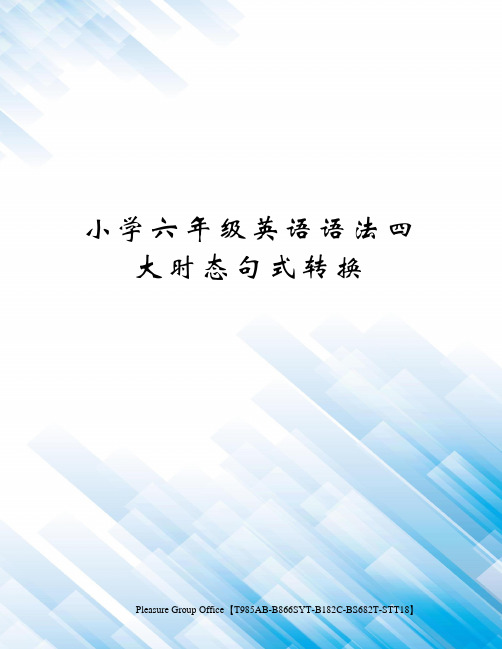
小学六年级英语语法四大时态句式转换Pleasure Group Office【T985AB-B866SYT-B182C-BS682T-STT18】四大时态复习1. 一般现在时(1)一般现在时的构成(肯定句)☆ be动词:主语+be(am,is,are)+其它。
如:I am a boy.我是一个男孩。
☆行为动词:主语+行为动词(+其它)。
如:We study English.我们学习英语。
☆当主语为第三人称单数(he, she,it)时,要在动词后加"-s"或"-es"。
如:Mary likes Chinese. 玛丽喜欢汉语。
(2)一般现在时的变化☆ . be动词的变化。
[否定句]:主语+ be + not +其它。
如:He is not a worker.他不是工人。
[一般疑问句]:Be +主语+其它。
如:-Are you a student -Yes. I am. / No, I'm not.[特殊疑问句]:疑问词+一般疑问句。
如:Where is my bike☆ .行为动词的变化。
[否定句]:主语+ don't( doesn't ) +动词原形(+其它)。
如:I don't like bread.当主语为第三人称单数时,要用doesn't构成否定句。
如:He doesn't often play.[一般疑问句]:Do( Does ) +主语+动词原形+其它。
如:- Do you often play football- Yes, I do. / No, I don't.当主语为第三人称单数时,要用does构成一般疑问句。
如:- Does she go to work by bike - Yes, she does. / No, she doesn't.[特殊疑问句]:疑问词+一般疑问句。
小学六年级英语语法四大时态句式转换

四大时态复习1. 一般现在时1一般现在时的构成肯定句☆ be动词:主语+beam;is;are+其它..如:I am a boy.我是一个男孩..☆行为动词:主语+行为动词+其它..如:We study English.我们学习英语..☆当主语为第三人称单数he; she;it时;要在动词后加"-s"或"-es"..如:Mary likes Chinese. 玛丽喜欢汉语..2一般现在时的变化☆ . be动词的变化..否定句:主语+ be + not +其它..如:He is not a worker.他不是工人..一般疑问句:Be +主语+其它.. 如:-Are you a student -Yes. I am. / No; I'm not.特殊疑问句:疑问词+一般疑问句..如:Where is my bike ☆ .行为动词的变化..否定句:主语+ don't doesn't +动词原形+其它..如:I don't like bread.当主语为第三人称单数时;要用doesn't构成否定句..如:He doesn't often play.一般疑问句:Do Does +主语+动词原形+其它..如:- Do you often play football- Yes; I do. / No; Idon't.当主语为第三人称单数时;要用does构成一般疑问句..如:- Does she go to work by bike - Yes; she does. / No; she doesn't.特殊疑问句:疑问词+一般疑问句..如:How does your father go to work 动词+s的变化规则1.一般情况下;直接加-s;如:cook-cooks; milk-milks2.以s. x. sh. ch. o结尾;加-es;如:guess-guesses; wash-washes; watch-watches; go-goes3.以“辅音字母+y”结尾;变y为i; 再加-es;如:study-studies2.现在进行时(1)一般现在时的构成: beam;is; are+ 动词的ing形式..如:I am reading. 我正在读书(2)现在进行时的否定句在be后加not;即beam;is; are + not + 动词的ing形式..如:She is not doing her homework now. 她现在没有做作业..(3)现在进行时的一般疑问句把be动词调到句首;即 Beam;is; are + 人 + 动词ing 形式..如:Are you drinking milk now 你现在在喝牛奶吗(4)现在进行时的特殊疑问的基本结构为:疑问词+ be + 人+ 动词ing 如:Where are you going 你现在去哪但who当主语时其结构为:Who + be + 动词ing如:Who is talking to you 谁在和你说话动词加ing的变化规则1.一般情况下;直接加ing;如:cook-cooking2.以不发音的e结尾;去e加ing;如:make-making; taste-tasting3.如果末尾是一个元音字母和一个辅音字母;双写末尾的辅音字母;再加ing;如:run-running; stop-stopping3.一般将来时1一般将来时基本结构:①be going to + do动词原形;②will+ do动词原形. 2否定句:在be动词am; is; are后加not或情态动词will后加not成won’t..结构为:beam; is; are + not + 动词原形 will not + 动词原形 will not = won’t例如:①I’m going to have a picnic this afternoon.→I’m not going to have a picnic this afternoon.②I will go shopping this weekend.→I will not go shopping this weekend.= I won’t go shopping this weekend.3一般疑问句:be或will提到句首;some改为any; and改为or;第一二人称互换..例如:①We are going to go on an outing this weekend.→ Are you going to go on an outing this weekend② I will play football tomorrow afternoon.→ Will you play football tomorrow afternoon4特殊疑问句①问人用Who例如:I’m going to New York soon. →Who’s going to New York soon.②问干什么用What …do.例如: My father is going to watch a race with me this afternoon.→What is your father going to do with you this afternoon.③问什么时候用When.例如:She’s going to go to bed at nine. →When is she going to bed 4.一般过去时1.肯定句 be动词在一般过去时中的变化:☆ am 和is在一般过去时中变为was..was not=wasn’t☆ are在一般过去时中变为were..were not=weren’t行为动词在一般过去时的句子中要变成过去式一般是在句子后面加ed(2)否定句:be动词变成 was notwasn’t 或 were not weren’t如:He wasn’t a teacher two years ago.didn’t +动词原形如:Jim didn’t go home yesterday.(3)一般疑问句有be动词的一般疑问句把was或were调到句首..如:Were you a teacher two years ago句中没有be动词的一般过去时的句子;在句首加did;句子中的动词过去式变回原形..如:Did Jim go home yesterday4特殊疑问句:①疑问词+did+主语+动词原形如:What did Jim do yesterday②疑问词是who时:疑问词+动词过去式如:Who went to home yesterday动词过去式变化规则:☆.一般在动词末尾加-ed;如:pull-pulled; cook-cooked☆.结尾是e加d;如:taste-tasted☆.末尾只有一个元音字母和一个辅音字母的重读闭音节;应双写末尾的辅音字母;再加-ed;如:stop-stopped☆.以“辅音字母+y”结尾的;变y为i; 再加-ed;如:study-studied☆.不规则动词过去式:am;is-was; are-were; do-did; see-saw; say-said; give-gave; get-got;go-went; come-came; have-had; eat-ate; take-took;run-ran; sing-sang; put-put; make-made; read-read; write-wrote;draw-drew; drink-drank; fly-flew; ride-rode;speak-spoke; sweep-swept; swim-swam; sit-sat随堂练习一、写出下列动词的第三人称单数drink ________ go _______ stay ________ make ________ look _________ have_______ pass_______ carry ____ come________ watch______ plant_______ fly ________study_______ brush________ do_________ teach_______二、按照要求改写句子1. Daniel watches TV every evening.改为否定句___________________________________________________2. I do my homework every day.改为一般疑问句;作否定回答________________________________________________________3. She likes milk.改为一般疑问句;作肯定回答___________________________4. I like taking photos in the park.对划线部分提问________________________________________________________5. John comes from Canada.对划线部分提问___________________________________________________三.写出下列动词的现在分词:play________ run__________ swim _________make__________ go_________ like________ write________ _ski___________ read________ have_________ sing ________ dance_________ put_________ see________ buy _________ love____________ live_______ take_________ come ________ get_________ stop_________ sit ________ begin________ shop___________四、句型转换:1. They are doing housework .改成否定句_____________________________________________________________2.The students are cleaning the classroom . 改一般疑问句并作肯定和否定回答__________________________________________________________________________________________________________________________________3.I’m playing the football in the playground .对划线部分进行提问_________________________________________________________________4.Tom is reading books in his study . 对划线部分进行提问_________________________________________________________________五.填空..1. 我打算明天和朋友去野炊..I_____ _______ _________ have a picnic with my friends.I ________ have a picnic with my friends.2. 下个星期一你打算去干嘛我想去打篮球..What ________ ________ _________ _________ _________ next Monday I _______ ______ _____ play basketball.What _________ you do next Monday I ________ play basketball.3. 你妈妈这个周末去购物吗是;她要去买一些水果.._____ your mother _______ ________ go shopping this ___________ Yes; she _________. She ______ ________ __________ buy some fruit.4. 你们打算什么时候见面..What time _______ you _________ __________ meet5. Nancy is going to go camping.改否定Nancy ________ going to go camping.6. I’ll go and join them.改否定I _______ go ______ join them.7. I’m going to get up at 6:30 tomorrow.改一般疑问句________ _______ ________ to get up at 6:30 tomorrow8. We will meet at the bus stop at 10:30.改一般疑问句_______ ________ meet at the bus stop at 10:30.9. She is going to listen to music after school.对划线部分提问________ _______ she ________ ________ _________ after school10. My father and mother are going to see a play the day after tomorrow.对划线部分提问_________ _________ going to see a play the day after tomorrow.七.写出下列动词的过去式fly_______ plant________ are ________ drink_________ play_______ go________make ________ does_________ dance________ worry________ ask _____ taste_________ eat__________ draw________ put ______ throw________ kick_________ pass_______do ________八、句型转换1. It was exciting.否定句:________________________________________________ 一般疑问句:____________________________________________ 肯、否定回答:__________________________________________ 2. All the students were very excited.否定句:________________________________________________ 一般疑问句:____________________________________________ 肯、否定回答:__________________________________________ 3. They were in his pocket.否定句:________________________________________________ 一般疑问句:____________________________________________ 肯、否定回答:__________________________________________ 4. Su Hai took some photos at the Sports day.否定句:________________________________________________ 一般疑问句:____________________________________________ 肯、否定回答:__________________________________________ 5. Nancy went to school early.否定句:________________________________________________ 一般疑问句:____________________________________________ 肯、否定回答:__________________________________________ 6. We sang some English songs.否定句:________________________________________________一般疑问句:____________________________________________ 肯、否定回答:__________________________________________。
小学英语四大时态结构讲解

一般过去时的陈述句:主语+动词过去式+宾语一般过去时的否定句:主语+didn't +动词原形+宾语主语+ was/were not +宾语一般过去时的一般疑问句:Did + 主语+ 动词原形+宾语was/were +主语+宾语示过去某个时间发生的动作或存在的状态,常和表示过去的时间状语连用,如:yesterday, last night, in 1999, two weeks ago等;②表示过去经常或反复发生的动作,常和often, always等表示频度的副词连用;③规则动词过去式的构成如下:1在动词原形末尾+ed: look—looked, play—played2结尾是e的动词+d: live—lived, hope—hoped3结尾是“元音字母+辅音字母”的重读音节词,先双写这个辅音字母,再+ed: stop—stopped, trip—tripped4结尾是“辅音字母+y”的动词,先变y为i,再+ed: study—studied, carry—carried④不规则动词要逐一记忆,可参考不规则动词表;一般过去时的特殊疑问句::特殊疑问词+一般过去时的一般疑问句一般过去时态: 1 表示过去已经发生的事情,通常用“last week, ju st now, yesterday”等词; 2 be 动词的过去式: am/is—was are—were I/He/she/it wasnot…. You/we/they were…. 一般疑问句was, we re 放在句首; 3过去式基本结构肯定句Positive 动词过去式 I we nt shopping last night. 否定句Negative Didn’t + 动词原形 I d idn’t go shopping las t night. 一般疑问句Yes/No Did …+ 动词原形… Did you go shopping last night 特殊疑问句wh- What did…+ 动词原形… What did you do last night 4动词过去式的变化:规则动词的变化:一般动词 +ed planted,watered,climbed 以不发音的e 结尾 +d liked 辅音字母加y结尾 -y+ ied study—studied, cry- cr ied 重读闭音节单词,末尾只有一个辅音字母双写最后一个字母+ed st op –stopped plan - planned 不规则动词的变化:原形过去式原形过去式原形过去式原形过去式 sweep swept teach taught have had go went keep kept think thought do did find found sleep sl ept buy bought eat ate say said feel felt drink drank is/am wa s take took read read give gave are were mean meant put put si ng sang drive drove meet met cut cut begin began speak spoke m ake made let let ring rang write wrote see saw fly flew run ra n ride rode come came draw drew sit sat hear heard tell told g row grew learn learned/ learnt get got know knew一般现在时的陈述句:主语+动词原形或单三形式动词根据主语的变化而变化+宾语一般现在时的否定句:主语+don't/doesn't +动词原形+宾语主语+ am/is/are +not +宾语一般现在时的一般疑问句:Do/Does +主语+动词原形+宾语 Is / Are +主语+ 宾语特殊疑问句:特殊疑问词+一般现在时的一般疑问句1表示经常发生的动作或事情,通常用“usually, often, every day, sometimes,always,never”等词; 2基本结构: I / You / We / They He / She / It 肯定句Positive 动词原形V 动词第三人称单数形式V+S 否定句Negative don’t + 动词doesn’t + 动词原形一般疑问句Yes/No Do… Yes, I do. Does…动词原形…No,she doesn’t. wh- What do … How does she…动词原形… 3 动词第三人称单数形式 a. Most verbs +s walk-walks b. Verbs ending in a consonant +y -y +ies fly-flies c. Verbs ending in s, sh, ch or x +es watch-watches d. Others do-does ,have-has, go-goes现在进行时的陈述句:主语+ Be + 现在分词+ 宾语现在进行时的否定句:主语+ be+ not+ 现在分词+宾语现在进行时的一般疑问句:Be+主语+现在分词+宾语现在进行时的特殊疑问句:特殊疑问词+一般疑问句现在进行时,:1表示正在发生的动作,通常用“now,look”. 2基本形式:be + 动词+ing eg: I amnot doing my homework. You/We/They arenot reading. He/She/It isnot eating. What are you doing Is he reading 3动词的现在分词形式do+ing Most verbs +ing walk—walking Verbs ending in e -e + ing come—coming Short verbs ending in a vowel + a consonant Double consonant run-running swim-swimming一般将来时的陈述句:主语+will/be going to + 动词原形+宾语一般将来时的否定句:主语+won't/be+not going to +动词原形+宾语一般将来时的一般疑问句:Will + 主语+动词原形+宾语 Be + 主语+ going to +动词原形+宾语一般将来时的特殊疑问句:特殊疑问词+一般将来时的一般疑问句一般将来时: 一般将来时表示将来打算做的事或将要发生的事情; 结构:be going to +动词原形例如:I’m going to visit my grandpa next week. 与这个时态连用的时间状语常用: tonight, tomorrow, the day after tomorrow, next week, in three hours, two days later 等; 一般将来时态与其它结构表将来情况的区别:一般将来时态:主要从时间的角度表将要发生的动作或情况;一般将来时除了使用“shall/will + V…”以外,也可以使用下列的句式来表达; 1.be going to + V … 即将会……;打算将…… be going to 结构:①表主观上打算或准备做某事时; ②表有发生某事的预兆时; . They are going to have a competition with us in studies. It is going to rain. 据以上区别,故下面一句是错的: I am going to be eighteen years old next year. 应改为: I shall be eighteen years old next year. be about to do sth 结构:意为“刚要做某事”、“马上要做某事”强调时间之紧迫性; . We are about to discuss this problem. 我们将马上讨论这个问题; be to do sth 结构:表示按计划、安排、规定将实施某事或表示注定会发生某事; . When is the train to leave. shall与will用法的区别详见shall与will用法的区别及它两过去式用法的区别4. 一般将来时①一般将来时表示将来某一时间的动作或状态;常与tomorrow, next week, from now on, in the future等连用;②由助动词shall第一人称/will第二、三人称+动词原形构成;③美国英语则不管什么人称,一律用will;④“be going to+动词原形”表示即将发生的或最近打算进行的事:We are going to have a meeting today. 今天我们要开会;⑤一些动词go,come,start,move,sail,leave,arrive,stay等的进行时态可表示近期的计划和打算:I'm leaving for Beijing.我要去北京;⑥“be to+动词原形”。
小学六年级英语语法四大时态句式转换

四大时态复习1. 一般现在时(1)一般现在时的构成(肯定句)☆be动词:主语+be(am,is,are)+其它。
如:I am a boy.我是一个男孩。
☆行为动词:主语+行为动词(+其它)。
如:We study English.我们学习英语。
☆当主语为第三人称单数(he, she,it)时,要在动词后加"-s"或"-es"。
如:Mary likes Chinese. 玛丽喜欢汉语。
(2)一般现在时的变化☆. be动词的变化。
[否定句]:主语+ be + not +其它。
如:He is not a worker.他不是工人。
[一般疑问句]:Be +主语+其它。
如:-Are you a student -Yes. I am. / No, I'm not.[特殊疑问句]:疑问词+一般疑问句。
如:Where is my bike☆.行为动词的变化。
[否定句]:主语+ don't( doesn't ) +动词原形(+其它)。
如:I don't like bread.当主语为第三人称单数时,要用doesn't构成否定句。
如:He doesn't often play.[一般疑问句]:Do( Does ) +主语+动词原形+其它。
如:- Do you often play football- Yes, I do. / No, I don't.当主语为第三人称单数时,要用does构成一般疑问句。
如:- Does she go to work by bike - Yes, she does. / No, she doesn't.[特殊疑问句]:疑问词+一般疑问句。
如:How does your father go to work*动词+s的变化规则1.一般情况下,直接加-s,如:cook-cooks, milk-milks2.以s. x. sh. ch. o结尾,加-es,如:guess-guesses, wash-washes, watch-watches, go-goes 3.以“辅音字母+y”结尾,变y为i, 再加-es,如:study-studies2.现在进行时(1)一般现在时的构成:be(am,is, are)+ 动词的ing形式。
小学六年级英语语法四大时态句式转换
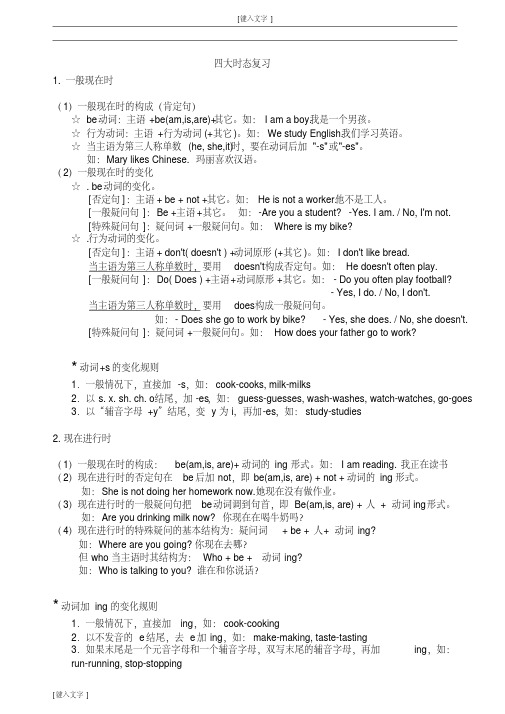
四大时态复习1. 一般现在时(1)一般现在时的构成(肯定句)☆be动词:主语+be(am,is,are)+其它。
如:I am a boy.我是一个男孩。
☆行为动词:主语+行为动词(+其它)。
如:We study English.我们学习英语。
☆当主语为第三人称单数(he, she,it)时,要在动词后加"-s"或"-es"。
如:Mary likes Chinese. 玛丽喜欢汉语。
(2)一般现在时的变化☆. be动词的变化。
[否定句]:主语+ be + not +其它。
如:He is not a worker.他不是工人。
[一般疑问句]:Be +主语+其它。
如:-Are you a student? -Yes. I am. / No, I'm not.[特殊疑问句]:疑问词+一般疑问句。
如:Where is my bike?☆.行为动词的变化。
[否定句]:主语+ don't( doesn't ) +动词原形(+其它)。
如:I don't like bread.当主语为第三人称单数时,要用doesn't构成否定句。
如:He doesn't often play.[一般疑问句]:Do( Does ) +主语+动词原形+其它。
如:- Do you often play football?- Yes, I do. / No, I don't.当主语为第三人称单数时,要用does构成一般疑问句。
如:- Does she go to work by bike? - Yes, she does. / No, she doesn't.[特殊疑问句]:疑问词+一般疑问句。
如:How does your father go to work?*动词+s的变化规则1.一般情况下,直接加-s,如:cook-cooks, milk-milks2.以s. x. sh. ch. o结尾,加-es,如:guess-guesses, wash-washes, watch-watches, go-goes 3.以“辅音字母+y”结尾,变y为i, 再加-es,如:study-studies2.现在进行时(1)一般现在时的构成:be(am,is, are)+ 动词的ing形式。
小学英语四种时态语法讲解

现在进行时
1、概念:现在(说话的瞬间)正在进行或发生的动 作,强调“此时此刻”。
2、标志词: look 看 ;listen听 ;now现在;
3.基本结构: be+动词ing(也叫现在分词) (主语不同,be的形式也不同) Look!It is raining outside. Listen! She is singing an English song. We are reading storybooks now.
I'm going to have a picnic this weekend.
Tomorrow will be Mid-Autumn Festival.
We will eat mooncakes.
口头小结一下:
一般过去时 一般现在时 现在进行时 一般将来时
概念 标志词
基本结构
课后思考与讨论
• 1、四种时态的肯定句如何转化为否定句? • 2、四种时态的肯定句如何转化为一般疑问句? • 3.四种时态的肯定句如何转化为特殊疑问句?
3.基本结构:
• ①be动词(注意be的人称变化,单数用was,复数 用were)
• I was in the classroom yesterday morning. • He was in the classroom yesterday morning. • They were in the classroom yesterday morning.
现在分词的变法规律:
• 1、一般在动词词尾加上-ing ,E.g. jump--jumping
• 2、以不发音字母e结尾的动词,先去e,再加-ing. have--having/write--writing/dance-dancing/
小学四大时态综合复习-小学英语四大时态

小学四大时态综合复习专题:四大时态综合复习第一:课程的衔接1. 第一次课的交流2.学生学习中所遇到的问题:第二:教学内容小学英语语法【一】一般现在时一、一般现在时的功能1.表示事物或人物的特征、状态。
如:The sky is blue.天空是蓝色的。
2.表示经常性或习惯性的动作。
如:I get up at six every day.我每天六点起床。
3.表示客观现实。
如:The earth goes around the sun.地球绕着太阳转。
二、一般现在时的构成1.be动词:肯定句:主语+be(am,is,are)+其它。
如:I am a boy. 我是一个男孩。
2.行为动词:肯定句:主语+行为动词(+其它)。
如:We study English.我们学习英语。
当主语为第三人称单数(he, she,it)时,要在动词后加"-s"或"-es"。
如:Mary likes Chinese.玛丽喜欢汉语。
动词+s的变化规则1.一般情况下,直接加-s,如:cook-cooks,2.以s. x. sh. ch. o结尾,加-es,如:guess-guesses, wash-washes, watch-watches, go-goes 3.以“辅音字母+y”结尾,变y为i, 再加-es,如:study-studies特殊:have----has三、一般现在时的变化1.be动词的变化。
否定句:主语+ be + not +其它。
如:He is not a worker.他不是工人。
一般疑问句:Be +主语+其它。
如:-Are you a student? -Yes. I am. / No, I'm not.特殊疑问句:疑问词+一般疑问句。
如:Where is my bike?2.行为动词的变化。
否定句:主语+ don't( doesn't ) +动词原形(+其它)。
小学六年级英语语法四大时态句式转换图文稿

小学六年级英语语法四大时态句式转换集团文件发布号:(9816-UATWW-MWUB-WUNN-INNUL-DQQTY-四大时态复习1. 一般现在时(1)一般现在时的构成(肯定句)☆ be动词:主语+be(am,is,are)+其它。
如:I am a boy.我是一个男孩。
☆行为动词:主语+行为动词(+其它)。
如:We study English.我们学习英语。
☆当主语为第三人称单数(he, she,it)时,要在动词后加"-s"或"-es"。
如:Mary likes Chinese. 玛丽喜欢汉语。
(2)一般现在时的变化☆ . be动词的变化。
[否定句]:主语+ be + not +其它。
如:He is not a worker.他不是工人。
[一般疑问句]:Be +主语+其它。
如:-Are you a student -Yes. I am. / No, I'm not.[特殊疑问句]:疑问词+一般疑问句。
如:Where is my bike ☆ .行为动词的变化。
[否定句]:主语+ don't( doesn't ) +动词原形(+其它)。
如:I don't like bread.当主语为第三人称单数时,要用doesn't构成否定句。
如:He doesn't often play.[一般疑问句]:Do( Does ) +主语+动词原形+其它。
如:- Do you often play football- Yes, I do. / No, Idon't.当主语为第三人称单数时,要用does构成一般疑问句。
如:- Does she go to work by bike - Yes, she does. / No, she doesn't.[特殊疑问句]:疑问词+一般疑问句。
如:How does your father go to work*动词+s的变化规则1.一般情况下,直接加-s,如:cook-cooks, milk-milks2.以s. x. sh. ch. o结尾,加-es,如:guess-guesses, wash-washes, watch-watches, go-goes3.以“辅音字母+y”结尾,变y为i, 再加-es,如:study-studies2.现在进行时(1)一般现在时的构成: be(am,is, are)+ 动词的ing形式。
小学英语语法-四大时态
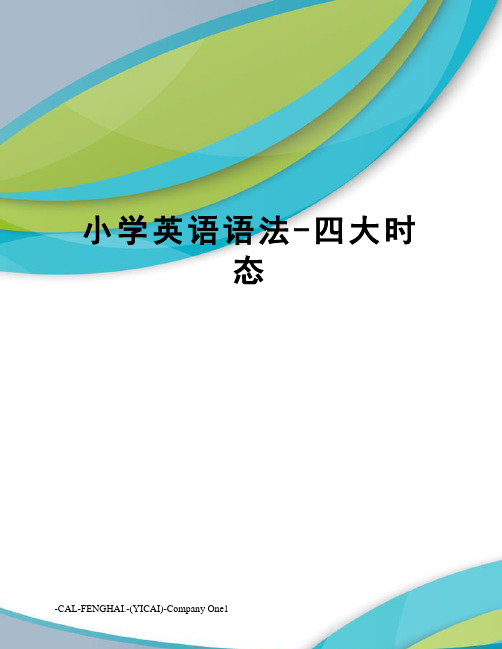
小学英语语法-四大时态-CAL-FENGHAI.-(YICAI)-Company One1四大时态复习1. 一般现在时(1)一般现在时的构成(肯定句)☆ be动词:主语+be(am,is,are)+其它。
如:I am a boy.我是一个男孩。
☆行为动词:主语+行为动词(+其它)。
如:We study English.我们学习英语。
☆当主语为第三人称单数(he, she,it)时,要在动词后加"-s"或"-es"。
如:Mary likes Chinese. 玛丽喜欢汉语。
(2)一般现在时的变化☆ . be动词的变化。
[否定句]:主语+ be + not +其它。
如:He is not a worker.他不是工人。
[一般疑问句]:Be +主语+其它。
如:-Are you a student-Yes. I am. / No, I'm not.[特殊疑问句]:疑问词+一般疑问句。
如:Where is my bike☆ .行为动词的变化。
[否定句]:主语+ don't( doesn't ) +动词原形(+其它)。
如:I don't like bread.当主语为第三人称单数时,要用doesn't构成否定句。
如:He doesn't often play.[一般疑问句]:Do( Does ) +主语+动词原形+其它。
如:- Do you often play football- Yes, I do. / No, Idon't.当主语为第三人称单数时,要用does构成一般疑问句。
如:- Does she go to work by bike- Yes, she does. / No, she doesn't.[特殊疑问句]:疑问词+一般疑问句。
如:How does your father go to work*动词+s的变化规则1.一般情况下,直接加-s,如:cook-cooks, milk-milks2.以s. x. sh. ch. o结尾,加-es,如:guess-guesses, wash-washes, watch-watches, go-goes3.以“辅音字母+y”结尾,变y为i, 再加-es,如:study-studies2.现在进行时(1)一般现在时的构成: be(am,is, are)+ 动词的ing形式。
小学六年级英语语法四大时态句式转换

四大时态复习1.一般此刻时(1)一般此刻时的组成(一定句)☆be 动词:主语 +be(am,is,are)+其余。
如: I am a boy.我是一个男孩。
☆行为动词:主语 +行为动词 (+其余 )。
如: We study English.我们学习英语。
☆当主语为第三人称单数 (he, she,it)时,要在动词后加 "-s" 或"-es"。
如: Mary likes Chinese. 玛丽喜爱汉语。
(2)一般此刻时的变化☆. be 动词的变化。
[否认句 ] :主语 + be + not +其余。
如: He is not a worker.他不是工人。
[一般疑问句 ]: Be +主语 +其余。
如: -Are you a student? -Yes. I am. / No, I'm not.[特别疑问句 ]:疑问词 +一般疑问句。
如: Where is my bike?☆ .行为动词的变化。
[否认句 ] :主语 + don't( doesn't ) +动词原形 (+其余 )。
如: I don't like bread.当主语为第三人称单数时,要用doesn't组成否认句。
如: He doesn't often play.[一般疑问句 ]: Do( Does ) +主语 +动词原形 +其余。
如: - Do you often play football? -Yes, I do. / No, I don't.当主语为第三人称单数时,要用does组成一般疑问句。
如: - Does she go to work by bike?- Yes, she does. / No, she doesn't.[特别疑问句 ]:疑问词 +一般疑问句。
如: How does your father go to work?*动词 +s 的变化规则1.一般状况下,直接加 -s,如: cook-cooks, milk-milks2.以 s. x. sh. ch. o结尾,加 -es,如: guess-guesses, wash-washes, watch-watches, go-goes 3.以“辅音字母 +y”结尾,变 y 为 i, 再加 -es,如: study-studies2.此刻进行时(1)一般此刻时的组成: be(am,is, are)+ 动词的 ing 形式。
小学六年级英语语法四大时态句式转换
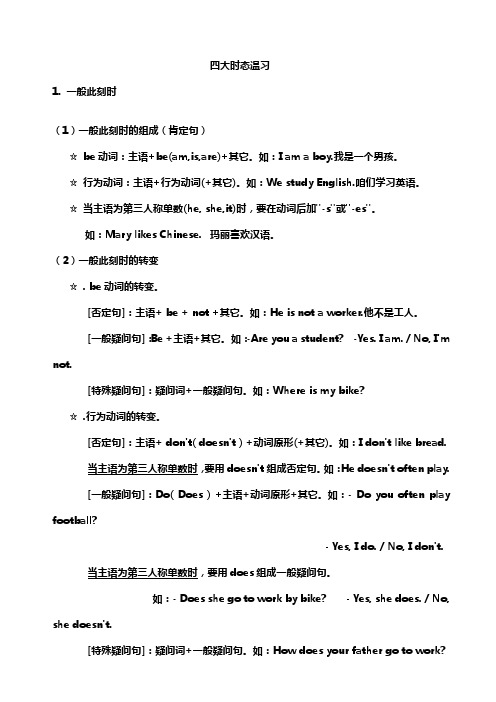
四大时态温习1. 一般此刻时(1)一般此刻时的组成(肯定句)☆be动词:主语+be(am,is,are)+其它。
如:I am a boy.我是一个男孩。
☆行为动词:主语+行为动词(+其它)。
如:We study English.咱们学习英语。
☆当主语为第三人称单数(he, she,it)时,要在动词后加"-s"或"-es"。
如:Mary likes Chinese. 玛丽喜欢汉语。
(2)一般此刻时的转变☆ . be动词的转变。
[否定句]:主语+ be + not +其它。
如:He is not a worker.他不是工人。
[一般疑问句]:Be +主语+其它。
如:-Are you a student? -Yes. I am. / No, I'm not.[特殊疑问句]:疑问词+一般疑问句。
如:Where is my bike?☆ .行为动词的转变。
[否定句]:主语+ don't( doesn't ) +动词原形(+其它)。
如:I don't like bread.当主语为第三人称单数时,要用doesn't组成否定句。
如:He doesn't often play.[一般疑问句]:Do( Does ) +主语+动词原形+其它。
如:- Do you often play football?- Yes, I do. / No, I don't.当主语为第三人称单数时,要用does组成一般疑问句。
如:- Does she go to work by bike? - Yes, she does. / No, she doesn't.[特殊疑问句]:疑问词+一般疑问句。
如:How does your father go to work?*动词+s的转变规则1.一般情况下,直接加-s,如:cook-cooks, milk-milks2.以s. x. sh. ch. o结尾,加-es,如:guess-guesses, wash-washes, watch-watches, go-goes3.以“辅音字母+y”结尾,变y为i, 再加-es,如:study-studies2.此刻进行时(1)一般此刻时的组成:be(am,is, are)+ 动词的ing形式。
小学英语语法专题四:四大时态
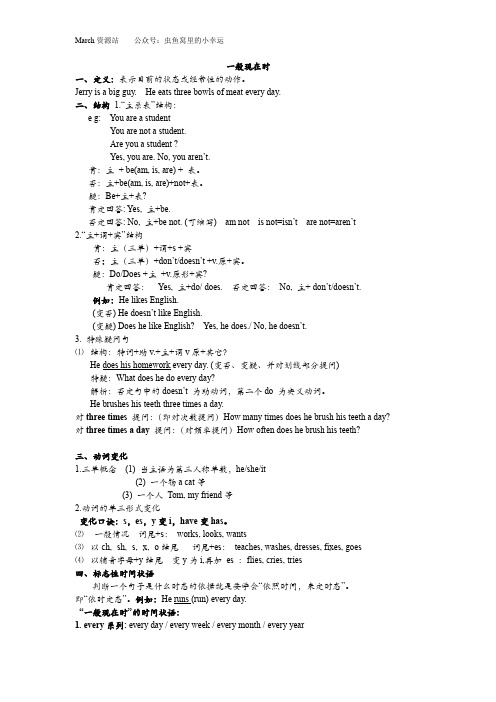
一般现在时一、定义:表示目前的状态或经常性的动作。
Jerry is a big guy. He eats three bowls of meat every day.二、结构1.“主系表”结构:e g: You are a studentYou are not a student.Are you a student ?Yes, you are. No, you aren’t.肯:主+ be(am, is, are) + 表。
否:主+be(am, is, are)+not+表。
疑:Be+主+表?肯定回答: Yes, 主+be.否定回答:No, 主+be not. (可缩写) am not is not=isn’t are not=aren’t2.“主+谓+宾”结构肯:主(三单)+谓+s +宾否:主(三单)+don’t/doesn’t +v.原+宾。
疑:Do/Does +主+v.原形+宾?肯定回答:Yes, 主+do/ does. 否定回答:No, 主+ don’t/doesn’t.例如:He likes English.(变否) He doesn’t like English.(变疑) Does he like English? Yes, he does./ No, he doesn’t.3. 特殊疑问句⑴结构:特词+助v.+主+谓v原+其它?He does his homework every day. (变否、变疑、并对划线部分提问)特疑:What does he do every day?解析:否定句中的doesn’t 为助动词,第二个do 为实义动词。
He brushes his teeth three times a day.对three times 提问:(即对次数提问)How many times does he brush his teeth a day?对three times a day提问:(对频率提问)How often does he brush his teeth?三、动词变化1.三单概念(1) 当主语为第三人称单数,he/she/it(2) 一个物a cat等(3) 一个人Tom, my friend等2.动词的单三形式变化变化口诀:s,es,y变i,have变has。
小学教育英语语法英语四个基本时态

精选文档英语的四个基本时态(一)---------一般此刻时A、一般此刻时主要用动词原形表示,但第三人称单数后要加-s。
动词词尾加-s与名词复数词尾的方法同样。
(动词have第三人称单数用has,系动词be的第三人称单数用is)。
1、一般在词尾加-s(包含以e结尾的词)-s在清辅音后读[s],如like-likes[la?ks]-s在浊辅音后读”[z],read如-reads[r?:dz]2、以s,x,sh,ch,等结尾的词加-es,-es读[?z],以o结尾的加-es,读[s]如watch-watches[w?t??z],go-goes[g??s]3、以f(fe)结尾的词变f(fe)为ves,-ves读[vz]4、以辅音字母+y结尾的词,把y改i后,再加-es,读[?z],如study-studies[st?d?z]B、什么状况下用一般此刻时?1、表示此刻常常或频频发生的动作或存在的状态。
常常和often,always,usually,everyday等时间状语连用。
比如:Damingisastudent. 大明是名学生。
Shelikespopmusic. 她喜爱流行音乐。
Hesmokesalot. 他抽好多烟。
2、表示主语的特点、性格、能力等。
比如:Lindalikeseatingnoodles. 琳达喜爱吃面条。
Shehasaroundface. 她有一张圆脸。
3、表示客观事实或广泛真谛。
比如:Thesunrisesintheeast. 太阳从东方升起。
Themoongoesroundtheearth. 月球绕着地球转。
Summerfollowsspring. 春季以后是夏季。
.精选文档4、表示安排或划好的未来生的作。
比如:Wheredowegonow? 我在要去哪里?Theplanetakesoffat11:30. 机11:30起。
C、一般在的句子种:1、述句(主+ +其余)①必定形式:一般状况下用原形,当主是第三人称数注意加-s或-es,比如:Ihaveapencilcase. 我有一个笔盒。
译林版小学英语语法知识

译林版小学英语语法知识小学阶段我们研究了四种时态,现在将这四种时态进行归纳总结:一、一般现在时一般现在时的标志词包括always,usually,often,sometimes,never和every。
在一般现在时中,动词只有第三人称有词形变化,其他人称(如第一人称:I。
we;第二人称:you;第三人称复数:they、my friends)动词均用原形。
当主语是第三人称单数时,动词在一般现在时句子中的变化规律有以下几种:1.多数在动词后加s,如play—plays,like—likes。
2.以s,x,sh,ch,o结尾的动词加es,如wash—washes,catch—catches,do—does。
3.以辅音字母加y结尾,把y改为i再加es,如fly—flies,study—studies。
4.以元音字母加y结尾,直接加s,如buy—buys。
5.不规则变化,如have—has。
一般现在时的基本用法有以下几种:1.表示事物或人物的特征、状态,如The sky is blue.(天空是蓝色的)。
2.表示经常性或惯性的动作,如I get up at six every day.(我每天六点起床)。
3.表示客观现实,如XXX around the sun.(地球绕着太阳转)。
一般现在时的构成有以下两种:1.be动词:主语+be(am。
is。
are)+其它,如I am a boy.(我是一个男孩)。
2.行为动词:主语+行为动词(+其它),如XXX.(我们研究英语)。
一般现在时的句型包括肯定句、否定句和一般疑问句:1.肯定句:A。
be动词:主语+be+其它成分,如He is a worker.(他是一名工人)。
B。
行为动词:主语+动词(注意人称变化)+其它成分,如We like the little cat.(我们喜欢这只小猫)。
2.否定句:A。
be动词:主语+be+not+其它成分,如They are not students.(他们不是学生)。
小学英语语法及习题--四大基本时态
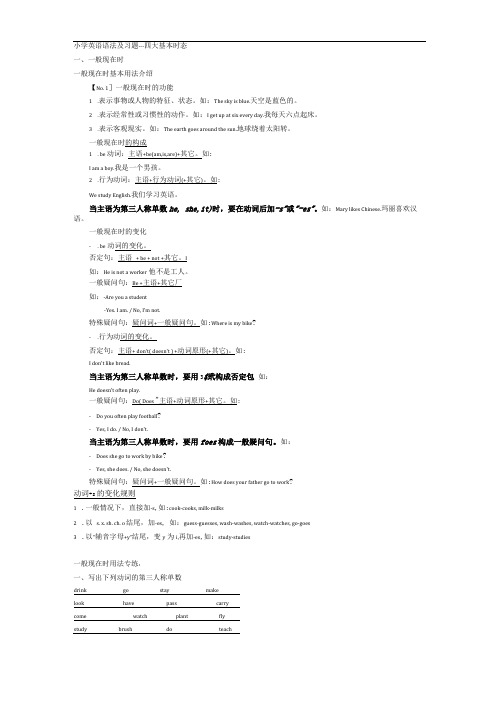
小学英语语法及习题---四大基本时态一、一般现在时一般现在时基本用法介绍【No. 1]一般现在时的功能1.表示事物或人物的特征、状态。
如:The sky is blue.天空是蓝色的。
2.表示经常性或习惯性的动作。
如:I get up at six every day.我每天六点起床。
3.表示客观现实。
如:The earth goes around the sun.地球绕着太阳转。
一般现在时的构成1. be 动词:主语+be(am,is,are)+其它。
如:I am a boy.我是一个男孩。
2.行为动词:主语+行为动词(+其它)。
如:We study English.我们学习英语。
当主语为第三人称单数he, she,it)时,要在动词后加-s"或"-es"。
如:Mary likes Chinese.玛丽喜欢汉语。
一般现在时的变化-. be动词的变化。
否定句:主语+ be + not +其它。
I如:He is not a worker他不是工人。
一般疑问句:Be +主语+其它厂如:-Are you a student-Yes. I am. / No, I'm not.特殊疑问句:疑问词+一般疑问句。
如:Where is my bike?-.行为动词的变化。
否定句:主语+ don't( doesn't ) +动词原形(+其它)。
如:I don't like bread.当主语为第三人称单数时,要用3$玳构成否定包如:He doesn't often play.一般疑问句:Do( Does "主语+动词原形+其它。
如:-Do you often play football-Yes, I do. / No, I don't.当主语为第三人称单数时,要用foes构成一般疑问句。
如:-Does she go to work by bike-Yes, she does. / No, she doesn't.特殊疑问句:疑问词+一般疑问句。
小学英语四大时态
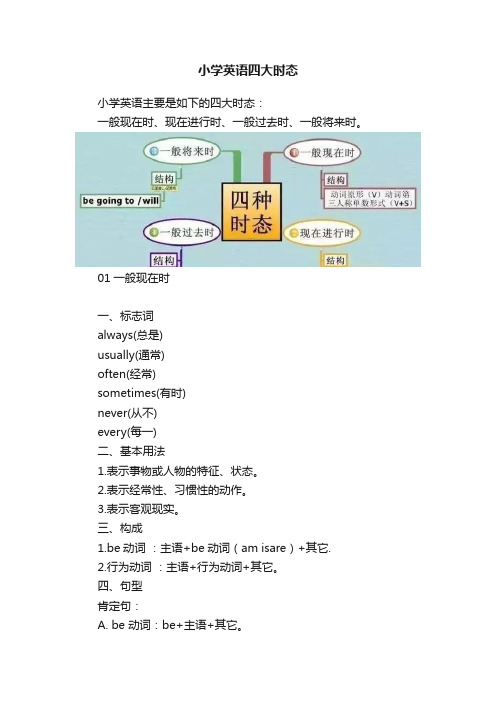
小学英语四大时态小学英语主要是如下的四大时态:一般现在时、现在进行时、一般过去时、一般将来时。
01一般现在时一、标志词always(总是)usually(通常)often(经常)sometimes(有时)never(从不)every(每一)二、基本用法1.表示事物或人物的特征、状态。
2.表示经常性、习惯性的动作。
3.表示客观现实。
三、构成1.be动词:主语+be动词(am isare)+其它.2.行为动词:主语+行为动词+其它。
四、句型肯定句:A. be 动词:be+主语+其它。
B. 行为动词:主语+动词(注意人称变化)+其它。
否定句:A.be动词:主语+be+not+其它。
B.行为动词:主语+助动词(do/does)+not+d动词原形+其它一般疑问句:A.be动词:be+主语+其它。
B.行为动词:助动词(Do/Does)+主语+动词原形+其他.特殊疑问词:疑问词+一般疑问句02现在进行时一、标志词now(现在), look(看),listen(听)二、基本用法表示现阶段正在进行的动作三、基本结构1.肯定句:主语+be动词+动词现在分词(ing)+其它。
2.否定句:主语+be动词+not+动词现在分词(ing)+其它。
3.一般疑问句:be动词+主语+现在分词(ing)+其它。
4.特殊疑问句:疑问词+一般疑问句。
03一般将来时一、标志词tomorrow(明天),soon(不久),will(将要=be going to)二、基本用法表示在在将来某个时间要发生的动作或存在的状态。
三、基本结构1.肯定句:主语 + be going to + 动词原形。
主语+will+动词原形。
2.否定句:主语 + be going to +动词原形。
主语+won’t + 动词原形3.一般疑问句:Be + 主语 + going to+动词原形Will + 主语 + 动词原形4.特殊疑问句:疑问词+一般疑问句04一般过去时一、标志词yesterday(昨天),ago(以前),before(在...之前)二、用法1.表示过去某个时间发生的动作或存在的状态,常和表示过去的时间状语连用。
- 1、下载文档前请自行甄别文档内容的完整性,平台不提供额外的编辑、内容补充、找答案等附加服务。
- 2、"仅部分预览"的文档,不可在线预览部分如存在完整性等问题,可反馈申请退款(可完整预览的文档不适用该条件!)。
- 3、如文档侵犯您的权益,请联系客服反馈,我们会尽快为您处理(人工客服工作时间:9:00-18:30)。
四大时态复习1. 一般现在时(1)一般现在时的构成(肯定句)☆be动词:主语+be(am,is,are)+其它。
如:I am a boy.我是一个男孩。
☆行为动词:主语+行为动词(+其它)。
如:We study English.我们学习英语。
☆当主语为第三人称单数(he, she,it)时,要在动词后加"-s"或"-es"。
如:Mary likes Chinese. 玛丽喜欢汉语。
(2)一般现在时的变化☆. be动词的变化。
[否定句]:主语+ be + not +其它。
如:He is not a worker.他不是工人。
[一般疑问句]:Be +主语+其它。
如:-Are you a student? -Yes. I am. / No, I'm not.[特殊疑问句]:疑问词+一般疑问句。
如:Where is my bike?☆.行为动词的变化。
[否定句]:主语+ don't( doesn't ) +动词原形(+其它)。
如:I don't like bread.当主语为第三人称单数时,要用doesn't构成否定句。
如:He doesn't often play.[一般疑问句]:Do( Does ) +主语+动词原形+其它。
如:- Do you often play football?- Yes, I do. / No, I don't.当主语为第三人称单数时,要用does构成一般疑问句。
如:- Does she go to work by bike? - Yes, she does. / No, she doesn't.[特殊疑问句]:疑问词+一般疑问句。
如:How does your father go to work?*动词+s的变化规则1.一般情况下,直接加-s,如:cook-cooks, milk-milks2.以s. x. sh. ch. o结尾,加-es,如:guess-guesses, wash-washes, watch-watches, go-goes 3.以“辅音字母+y”结尾,变y为i, 再加-es,如:study-studies2.现在进行时(1)一般现在时的构成:be(am,is, are)+ 动词的ing形式。
如:I am reading. 我正在读书(2)现在进行时的否定句在be后加not,即be(am,is, are) + not + 动词的ing形式。
如:She is not doing her homework now. 她现在没有做作业。
(3)现在进行时的一般疑问句把be动词调到句首,即Be(am,is, are) + 人+ 动词ing形式。
如:Are you drinking milk now? 你现在在喝牛奶吗?(4)现在进行时的特殊疑问的基本结构为:疑问词+ be + 人+ 动词ing?如:Where are you going? 你现在去哪?但who当主语时其结构为:Who + be + 动词ing?如:Who is talking to you? 谁在和你说话?*动词加ing的变化规则1.一般情况下,直接加ing,如:cook-cooking2.以不发音的e结尾,去e加ing,如:make-making, taste-tasting3.如果末尾是一个元音字母和一个辅音字母,双写末尾的辅音字母,再加ing,如:run-running, stop-stopping3.一般将来时(1)一般将来时基本结构:①be going to + do(动词原形);②will+ do(动词原形). (2)[否定句]:在be动词(am, is, are)后加not或情态动词will后加not成won’t。
结构为:be(am, is, are) + not + 动词原形will not + 动词原形(will not = won’t) 例如:①I’m going to have a picnic this afternoon.→I’m not going to have a picnic this afternoon.②I will go shopping this weekend.→I will not go shopping this weekend.= I won’t go shopping this weekend.(3)[一般疑问句]:be或will提到句首,some改为any, and改为or,第一二人称互换。
例如:①We are going to go on an outing this weekend.→Are you going to go on an outing this weekend?②I will play football tomorrow afternoon.→Will you play football tomorrow afternoon?(4)[特殊疑问句]①问人用Who例如:I’m going to New York soon. →Who’s going to New York soon.②问干什么用What …do.例如:My father is going to watch a race with me this afternoon.→What is your father going to do with you this afternoon.③问什么时候用When.例如:She’s going to go to bed at nine. →When is she going to bed?4.一般过去时(1).[肯定句] be动词在一般过去时中的变化:☆am 和is在一般过去时中变为was。
(was not=wasn’t)☆are在一般过去时中变为were。
(were not=weren’t)行为动词在一般过去时的句子中要变成过去式(一般是在句子后面加ed)(2)[否定句]:be动词变成was not(wasn’t) 或were not (weren’t)如:He wasn’t a teacher two years ago.didn’t +动词原形如:Jim didn’t go home yesterday.(3)[一般疑问句]有be动词的一般疑问句把was或were调到句首。
如:Were you a teacher two years ago?句中没有be动词的一般过去时的句子,在句首加did,句子中的动词过去式变回原形。
如:Did Jim go home yesterday?(4)[特殊疑问句]:①疑问词+did+主语+动词原形?如:What did Jim do yesterday?②疑问词是who时:疑问词+动词过去式?如:Who went to home yesterday?* 动词过去式变化规则:☆.一般在动词末尾加-ed,如:pull-pulled, cook-cooked☆.结尾是e加d,如:taste-tasted☆.末尾只有一个元音字母和一个辅音字母的重读闭音节,应双写末尾的辅音字母,再加-ed,如:stop-stopped☆.以“辅音字母+y”结尾的,变y为i,再加-ed,如:study-studied☆.不规则动词过去式:am,is-was, are-were, do-did, see-saw, say-said, give-gave, get-got, go-went, come-came, have-had, eat-ate, take-took,run-ran, sing-sang, put-put, make-made, read-read, write-wrote, draw-drew, drink-drank, fly-flew, ride-rode,speak-spoke, sweep-swept, swim-swam, sit-sat【随堂练习】一、写出下列动词的第三人称单数drink ________ go _______ stay ________ make ________ look _________ have_______ pass_______ carry ____ come________ watch______ plant_______ fly ________study_______ brush________ do_________ teach_______二、按照要求改写句子1. Daniel watches TV every evening.(改为否定句)___________________________________________________2. I do my homework every day.(改为一般疑问句,作否定回答)________________________________________________________3. She likes milk.(改为一般疑问句,作肯定回答)___________________________4. I like taking photos in the park.(对划线部分提问)________________________________________________________5. John comes from Canada.(对划线部分提问)___________________________________________________三.写出下列动词的现在分词:play________ run__________ swim _________make__________ go_________ like________ write________ _ski___________ read________ have_________ sing ________ dance_________ put_________ see________ buy _________ love____________ live_______ take_________ come ________ get_________ stop_________ sit ________ begin________ shop___________四、句型转换:1. They are doing housework .(改成否定句)_____________________________________________________________2.The students are cleaning the classroom . ( 改一般疑问句并作肯定和否定回答)__________________________________________________________________________________________________________________________________3.I’m playing the football in the playground .(对划线部分进行提问)_________________________________________________________________4.Tom is reading books in his study . (对划线部分进行提问)_________________________________________________________________五.填空。
